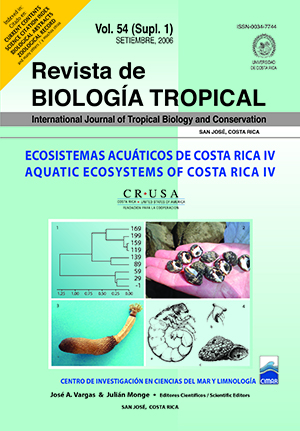Abstract
Trophic models were compared for mangrove fringed estuaries in Costa Rica (Gulf of Nicoya, at the Pacific shore) and Brazil (Caeté estuary, NE of Belem) in order to evaluate biomass and energy flow distributions, productivity and fisheries potential, and to obtain guidelines for conservation and management of these systems. As the same network modelling approach (ECOPATH II) and a similar number of system compartments were used, a comparison based on the network models seemed attractive. Differences in biotic structure, energy flow and resource productivity’s between both systems and their causes were assessed. They proved to be substantial and largely due to differences in topography, tidal regime and mangrove cover between both systems. While the Gulf of Nicoya is exposed to semidiurnal tides and an efficient daily water exchange between the mangrove stands and the gulf and thus to a strong mangrove matter export to the gulf water, the mangrove forest of the Caeté estuary is flushed each fortnight only and the largest part of the mangrove production thus remains within the forest. This is reflected in great differences in food web structure and the amount and type of resources produced in both systems. In the Gulf of Nicoya, detritus matter exported from the mangroves to the estuary feeds an aquatic food web with shrimps and other aquatic detritivores in the centre of the web, while in the Caeté estuary, most energy remains in the benthic domain of the mangrove forest where it is transferred to an enormous biomass of leaf consuming mangrove crabs, the principal resource of this system. Findings imply that generalizations among mangrove systems need to be tempered with caution and differences in trophic relationships among systems must be considered. Rev. Biol. Trop. 54 (Suppl. 1): 69-86. Epub 2006 Sept. 30.References
Baird, D. & R.E. Ulanowicz. 1993. Comparative study on the trophic structure, and ecosystem properties of four tidal estuaries. Mar. Ecol. Prog. Ser. 99: 221-237.
Christensen, V. & D. Pauly. 1992. ECOPATH II - a software of balancing steady state ecosystem models and calculating network characteristics. Ecol. Model. 61: 169-185.
Christensen, V. & D. Pauly (eds.). 1993. Trophic models of aquatic ecosystems. ICLARM Conference Proceedings 26: 390 p.
Dummermuth, A. 1997. Primärproduction des Phytoplanktons und des Mikrophytobenthos in einer nordbrasilianischen Mangrove (Braganca, Para). M.Sc. Thesis, Bremen University, Germany. 136 p.
Glaser, M., L Furtado, I. Nacimiento & G. Santana. 1997. Economy, Ecosystem and Society: mangroves and people in the Caete Bay, North Brazil. In Annual Conference, Development Studies Association University of East Anglia, Norwich, U.K. September 1997.
Jiménez, J.A. 1994. Los Manglares del Pacifico Centroamericano. Fundación UNA, Heredia, Costa Rica. 352 p.
Leontief, W.W. 1951. The structure of the U.S. economy. Oxford, New York, New York, USA.
Majkowski, J. 1982. Usefullness and applicability of sensitivity analysis in a multispecies approach to fisheries management. In: D. Pauly & G.I. Murphy (eds.). Theory and management of tropical fisheries. ICLARM Conference Proceedings 9: 149-165.
Palomares, M. 1987. Comparative studies on the food consumption of marine fishes with emphasis on species occurring in the Philippines. M.Sc. Thesis, University of the Philippines, Manila, Philippines. 107 p.
Palomares, M. & D. Pauly. 1989. A multiple regression model for predicting the food consumption of marine fish populations. Aust. J. Mar. Freshw. Res. 40: 259- 273.
Parsons, T.R., M. Takahashi & B. Hargrave. 1977. Biological Oceanographic Processes. Pergamon, New York, New York, USA. 332 p.
Pauly, D., V. Christensen, J. Dalsgaard, R. Froese & F. Torres, Jr. 1998. Fishing down the food web. Science 279: 860-863.
Rademaker, V. 1998. Ernährungsökologie, Habitatbeschreibung und Populationsstruktur der Mangrovenkrabbe Ucides cordatus (Linnaeus, 1763) im Caeté Mangrovenästuar, Nordbrasilien. M.Sc. Thesis, Bremen University, Germany. 94 p.
Rutledge, R.W., B.L. Bacore & R.J. Mulholland. 1976. Ecological stability: an information theory viewpoint. J. Theor. Biol. 57: 355-371.
Ulanowicz, R.E. 1986. Growth and Development: Ecosystems Phenomenology. Springer, New York, New York, USA. 203 p.
Ulanowicz, R.E. & K.H. Mann. 1981. Ecosystems under stress, p.133-137. In T. Platt, K.H. Mann & R.E. Ulanowicz (eds.). Mathematical models in biological oceanography. UNESCO, Paris, France.
Ulanowicz, R. E. & C.J. Puccia. 1990. Mixed trophic impacts in ecosystems. Coenosis 5: 7-16.
Vargas, J.A. 1995. The Gulf of Nicoya estuary, Costa Rica. Past, present and future cooperative research. Helgol. Meeres. 49: 821-828.
##plugins.facebook.comentarios##

This work is licensed under a Creative Commons Attribution 4.0 International License.
Copyright (c) 2006 Revista de Biología Tropical






